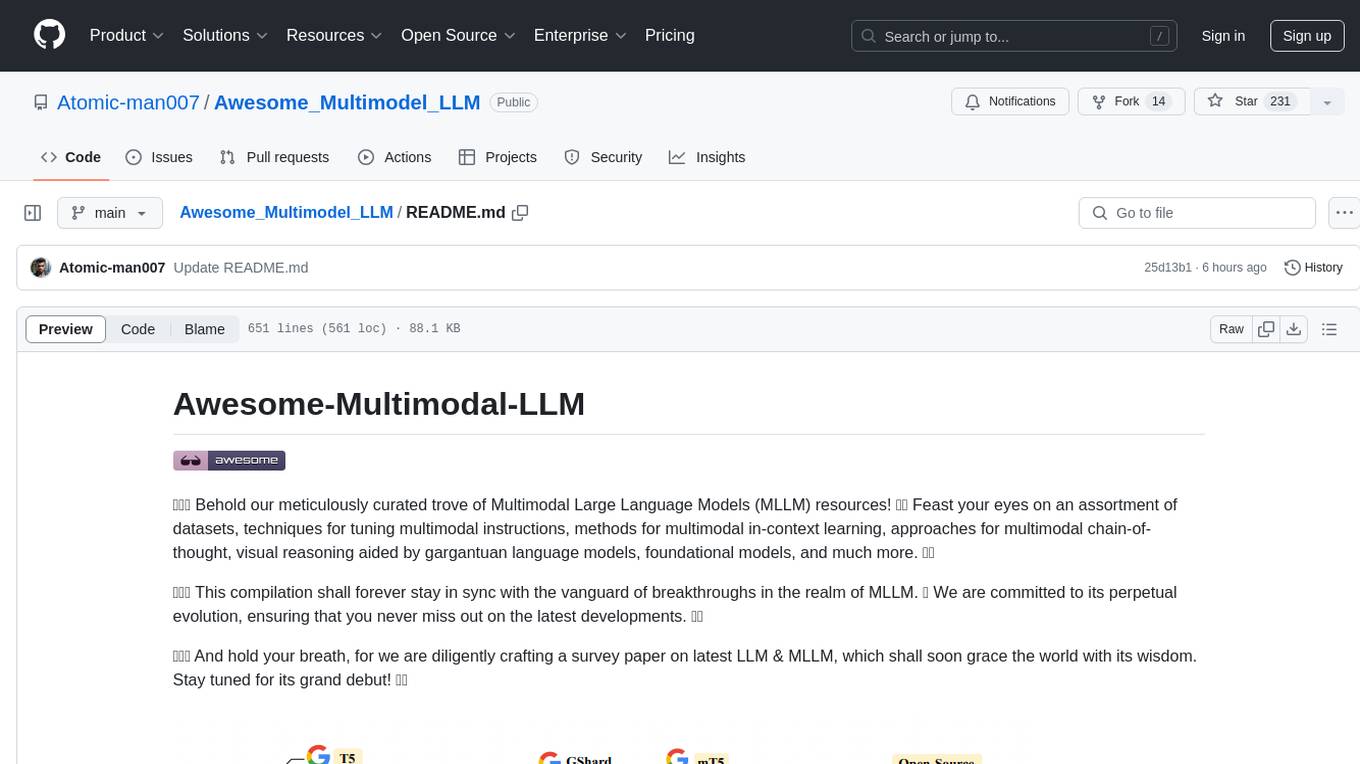
rulm
Language modeling and instruction tuning for Russian
Stars: 436
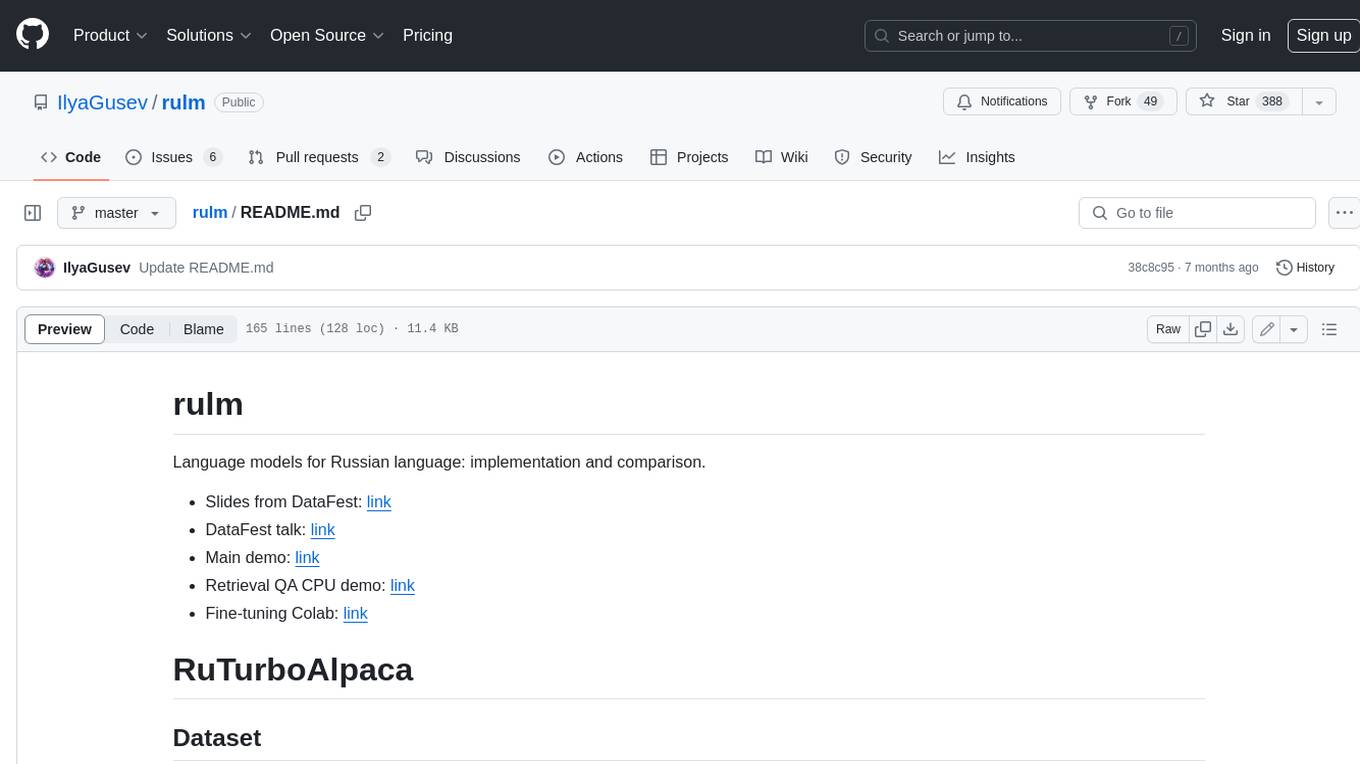
This repository contains language models for the Russian language, as well as their implementation and comparison. The models are trained on a dataset of ChatGPT-generated instructions and chats in Russian. They can be used for a variety of tasks, including question answering, text generation, and translation.
README:
Language models for Russian language: implementation and comparison.
- Slides from DataFest: link
- DataFest talk: link
- Main demo: link
- Retrieval QA CPU demo: link
- Fine-tuning Colab: link
- HuggingFace: link
- A dataset of ChatGPT-generated instructions in Russian.
- Based on the same principles as an original Alpaca.
- Instead of text-davinci-003 we used gpt-3.5-turbo.
- A script for dataset generation: generate_instructions.py
- Prompt: ru_instruct.txt
- Example:
### Задание:
Напишите краткую историю о двух лучших друзьях.
### Дано:
Имена друзей: Катя и Лена.
### Ответ:
Катя и Лена были лучшими друзьями с детства. Они были неразлучны и проводили много времени вместе, делясь своими мыслями и мечтами. Вместе они проходили через множество испытаний и всегда поддерживали друг друга. Когда они выросли, они пошли на разные университеты, но всегда оставались близкими. После окончания учебы они продолжили жить вместе и заниматься любимыми делами. Они оставались лучшими друзьями на протяжении всей жизни.
Warning: You should probably use Saiga models instead. They are actively supported and are better by side-by-side metrics.
- HuggingFace links:
- Training configs:
- Base models:
- Trained on Russian and English Alpacas. For training details see a separate README.
- HuggingFace: link
- A dataset of ChatGPT-generated chats in Russian.
- Based on the Baize paper.
- A script for dataset generation: generate_chat.py
- Prompt: ru_chat.txt
- Example:
Тема: Какие спицы (крючок) используете лично вы для вязания?
User: Какие спицы ты используешь для вязания?
Bot: Я, конечно, не могу вязать, но могу подсказать, что для вязания используются различные типы спиц. Например, круглые для вязания круговых изделий, двойные для вязания толстых ниток или деревянные для создания "теплых" изделий.
User: А какую марку спиц ты советуешь?
Bot: Это зависит от предпочтений каждого. Можно выбирать между разными марками и материалами, такими как металл, дерево, карбон, пластик. Многие мастера предпочитают Addi, Clover, ChiaoGoo, KnitPro, HiyaHiya. Каждая марка имеет свои особенности и уникальные особенности.
User: А какие спицы для вязания лучше всего подходят для начинающих?
Bot: Для новичков обычно рекомендуют спицы из дерева, так как они легче и позволяют лучше чувствовать нить. Круглые или двойные спицы также удобны для начинающих, потому что они не позволяют стежкам сползать с них.
- HuggingFace links:
- Training configs:
- Base models:
- Trained on 6 datasets: ru_turbo_saiga, ru_turbo_alpaca, ru_sharegpt_cleaned, oasst1_ru_main_branch, gpt_roleplay_realm, ru_turbo_alpaca_evol_instruct. The script for smart merging: create_chat_set.py
- HuggingFace: link
- A dataset of 200+ GPT-generated characters with 20 chats for each character.
- Example:
Имя: Кибер-Бабушка
Контекст: Кибер-Бабушка - это полу-робот, полу-человек, созданный для того, чтобы сохранить лучшие качества традиционных бабушек, такие как забота, доброта и мастерство в приготовлении вкусных блюд. Она знакома с передовыми технологиями, благодаря чему может обеспечить безопасность и удобство своим внукам и гостям. Кибер-бабушка способна помочь с любыми вопросами и с радостью делится своим опытом.
Приветствие: Здравствуй, дорогой! Чем могу помочь тебе сегодня?
Пример диалога:
- Пользователь: Привет, Кибер-Бабушка! Как приготовить пирог с яблоками?
- Персонаж: Ох, дорогой, с радостью расскажу! Возьми 3 яблока, очисти и нарежь тонкими ломтиками. Затем возьми 2 стакана муки, 1 стакан сахара, 200 г сливочного масла, 4 яйца и 1 чайную ложку разрыхлителя. Смешай все ингредиенты, выложи на противень и поставь в духовку на 180 градусов на 40 минут. Вуаля, пирог готов!
- Пользователь: Спасибо, Кибер-Бабушка!
- Персонаж: Всегда рада помочь, дорогой! Не забудь приходить еще!
See also:
- User-oriented questions: https://github.com/IlyaGusev/rulm/blob/master/self_instruct/data/user_oriented_ru_v2.jsonl
- Vicuna questions: https://github.com/IlyaGusev/rulm/blob/master/self_instruct/data/vicuna_question_ru.jsonl
- turbo vs gpt4: 46-8-122
- turbo vs saiga30b: 111-9-56
- turbo vs saiga30bq4_1: 121-9-46
- gigasaiga vs gpt3.5-turbo: 41-4-131
- saiga2_7b vs gpt3.5-turbo: 53-7-116
- saiga7b vs gpt3.5-turbo: 58-6-112
- saiga13b vs gpt3.5-turbo: 63-10-103
- saiga30b vs gpt3.5-turbo: 67-6-103
- saiga2_13b vs gpt3.5-turbo: 70-11-95
- saiga2_70b vs gpt3.5-turbo: 91-10-75
- saiga7b vs saiga2_7b: 78-8-90
- saiga13b vs saiga2_13b: 95-2-79
- saiga13b vs gigasaiga: 112-11-53
- RussianSuperGLUE: link
| Model | Final score | LiDiRus | RCB | PARus | MuSeRC | TERRa | RUSSE | RWSD | DaNetQA | RuCoS |
|---|---|---|---|---|---|---|---|---|---|---|
| LLaMA-2 13B LoRA | 71.8 | 39.8 | 48.9 / 54.3 | 78.4 | 91.9 / 76.1 | 79.3 | 74.0 | 71.4 | 90.7 | 78.0 / 76.0 |
| Saiga 13B LoRA | 71.2 | 43.6 | 43.9 / 50.0 | 69.4 | 89.8 / 70.4 | 86.5 | 72.8 | 71.4 | 86.2 | 85.0 / 83.0 |
| LLaMA 13B LoRA | 70.7 | 41.8 | 51.9 / 54.8 | 68.8 | 89.9 / 71.5 | 82.9 | 72.5 | 71.4 | 86.6 | 79.0 / 77.2 |
| ChatGPT zero-shot | 68.2 | 42.2 | 48.4 / 50.5 | 88.8 | 81.7 / 53.2 | 79.5 | 59.6 | 71.4 | 87.8 | 68.0 / 66.7 |
| LLaMA 70B zero-shot | 64.3 | 36.5 | 38.5 / 46.1 | 82.0 | 66.9 / 9.8 | 81.1 | 59.0 | 83.1 | 87.8 | 69.0 / 67.8 |
| RuGPT3.5 LoRA | 63.7 | 38.6 | 47.9 / 53.4 | 62.8 | 83.0 / 54.7 | 81.0 | 59.7 | 63.0 | 80.1 | 70.0 / 67.2 |
| Saiga 13B zero-shot | 55.4 | 29.3 | 42.0 / 46.6 | 63.0 | 68.1 / 22.3 | 70.2 | 56.5 | 67.5 | 76.3 | 47.0 / 45.8 |
For Tasks:
Click tags to check more tools for each tasksFor Jobs:
Alternative AI tools for rulm
Similar Open Source Tools

rulm
This repository contains language models for the Russian language, as well as their implementation and comparison. The models are trained on a dataset of ChatGPT-generated instructions and chats in Russian. They can be used for a variety of tasks, including question answering, text generation, and translation.
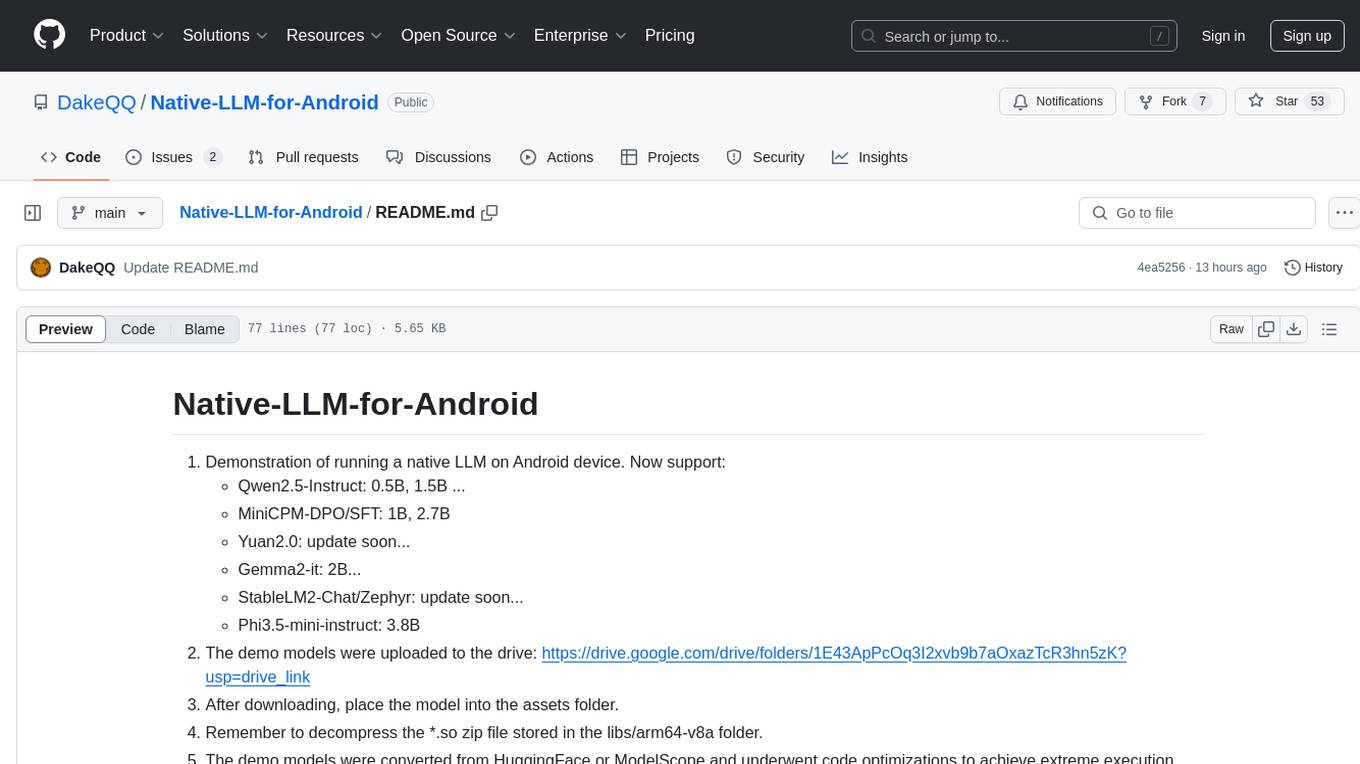
Native-LLM-for-Android
This repository provides a demonstration of running a native Large Language Model (LLM) on Android devices. It supports various models such as Qwen2.5-Instruct, MiniCPM-DPO/SFT, Yuan2.0, Gemma2-it, StableLM2-Chat/Zephyr, and Phi3.5-mini-instruct. The demo models are optimized for extreme execution speed after being converted from HuggingFace or ModelScope. Users can download the demo models from the provided drive link, place them in the assets folder, and follow specific instructions for decompression and model export. The repository also includes information on quantization methods and performance benchmarks for different models on various devices.
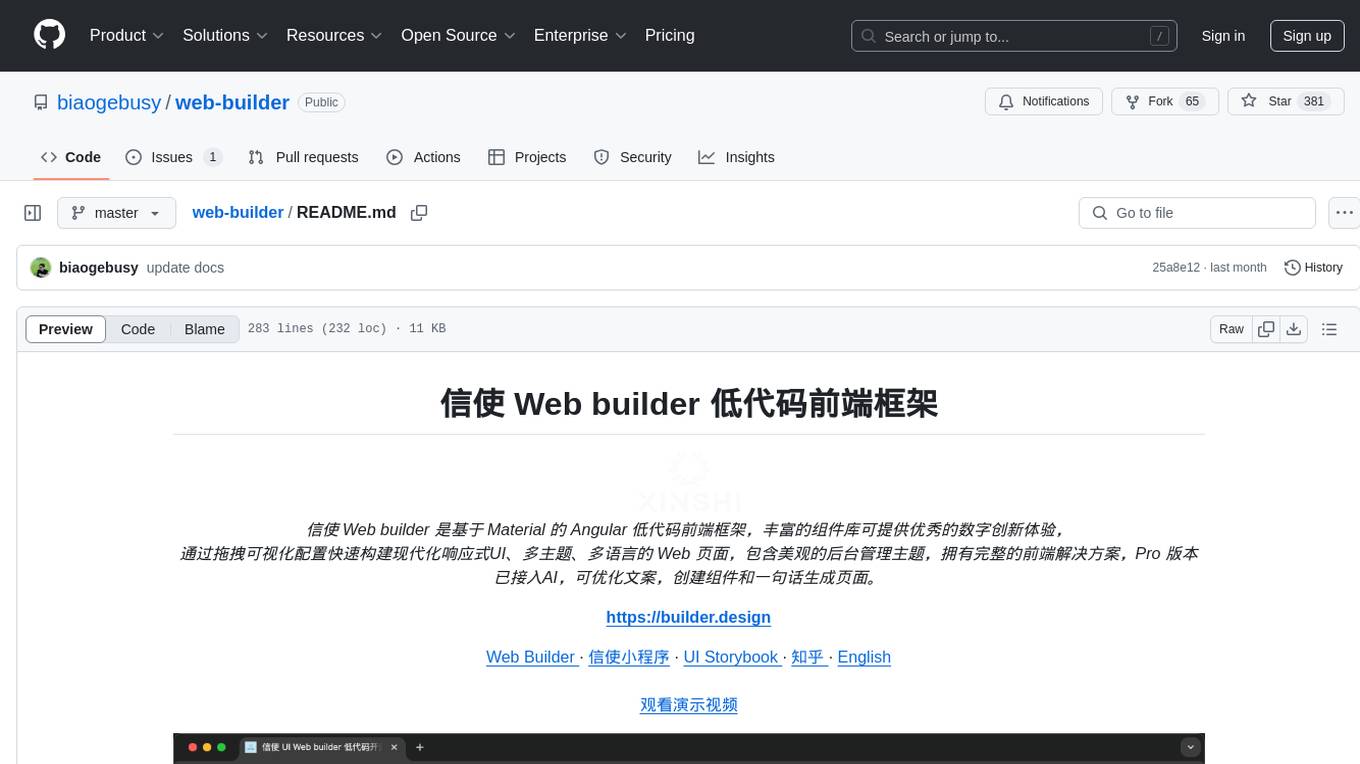
web-builder
Web Builder is a low-code front-end framework based on Material for Angular, offering a rich component library for excellent digital innovation experience. It allows rapid construction of modern responsive UI, multi-theme, multi-language web pages through drag-and-drop visual configuration. The framework includes a beautiful admin theme, complete front-end solutions, and AI integration in the Pro version for optimizing copy, creating components, and generating pages with a single sentence.
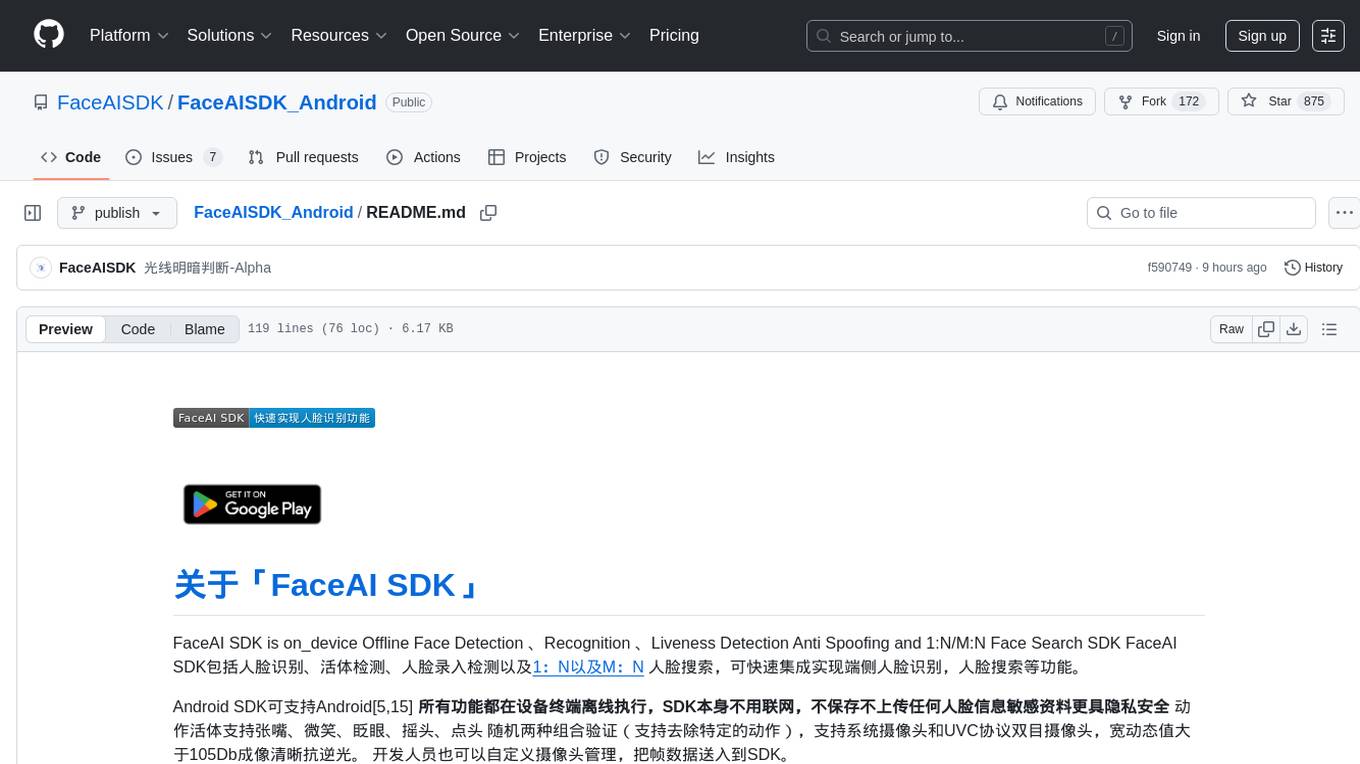
FaceAISDK_Android
FaceAI SDK is an on-device offline face detection, recognition, liveness detection, anti-spoofing, and 1:N/M:N face search SDK. It enables quick integration to achieve on-device face recognition, face search, and other functions. The SDK performs all functions offline on the device without the need for internet connection, ensuring privacy and security. It supports various actions for liveness detection, custom camera management, and clear imaging even in challenging lighting conditions.
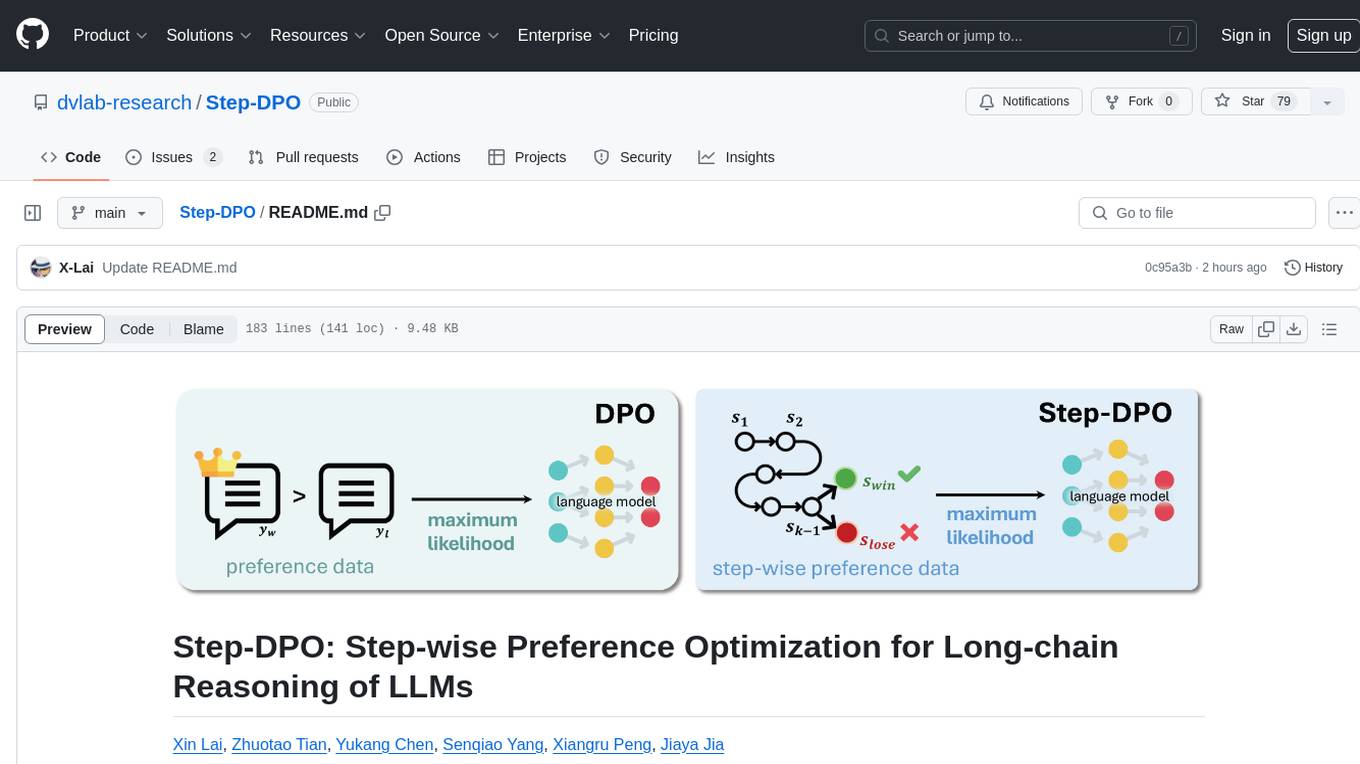
Step-DPO
Step-DPO is a method for enhancing long-chain reasoning ability of LLMs with a data construction pipeline creating a high-quality dataset. It significantly improves performance on math and GSM8K tasks with minimal data and training steps. The tool fine-tunes pre-trained models like Qwen2-7B-Instruct with Step-DPO, achieving superior results compared to other models. It provides scripts for training, evaluation, and deployment, along with examples and acknowledgements.
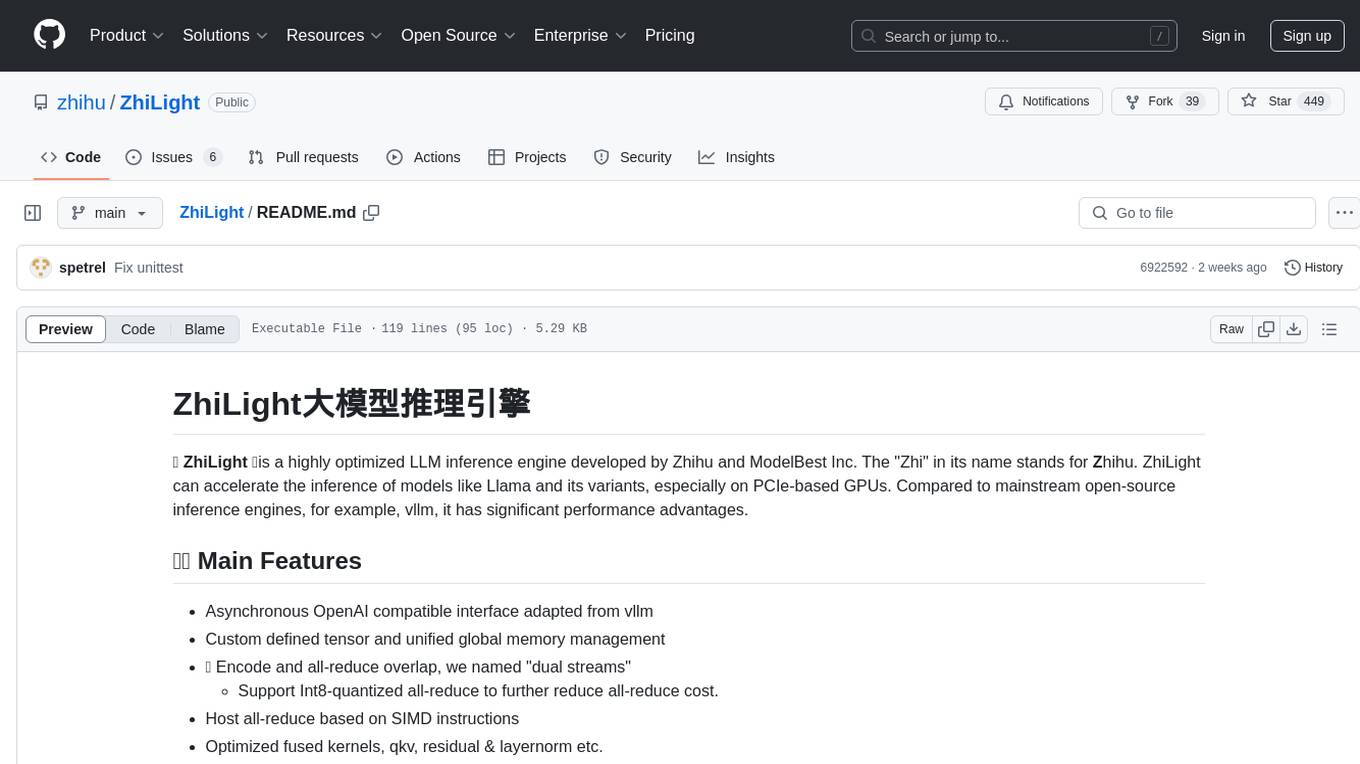
ZhiLight
ZhiLight is a highly optimized large language model (LLM) inference engine developed by Zhihu and ModelBest Inc. It accelerates the inference of models like Llama and its variants, especially on PCIe-based GPUs. ZhiLight offers significant performance advantages compared to mainstream open-source inference engines. It supports various features such as custom defined tensor and unified global memory management, optimized fused kernels, support for dynamic batch, flash attention prefill, prefix cache, and different quantization techniques like INT8, SmoothQuant, FP8, AWQ, and GPTQ. ZhiLight is compatible with OpenAI interface and provides high performance on mainstream NVIDIA GPUs with different model sizes and precisions.
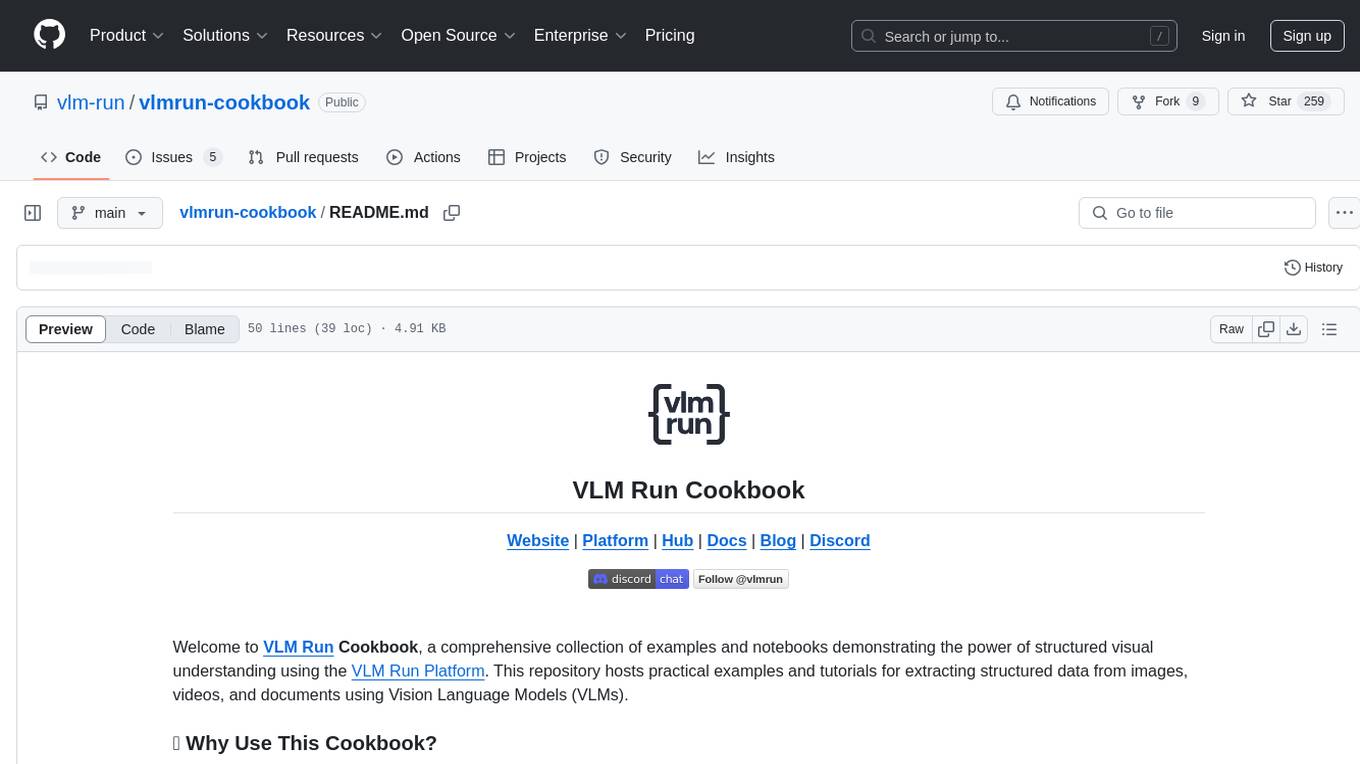
vlmrun-cookbook
VLM Run Cookbook is a repository containing practical examples and tutorials for extracting structured data from images, videos, and documents using Vision Language Models (VLMs). It offers comprehensive Colab notebooks demonstrating real-world applications of VLM Run, with complete code and documentation for easy adaptation. The examples cover various domains such as financial documents and TV news analysis.
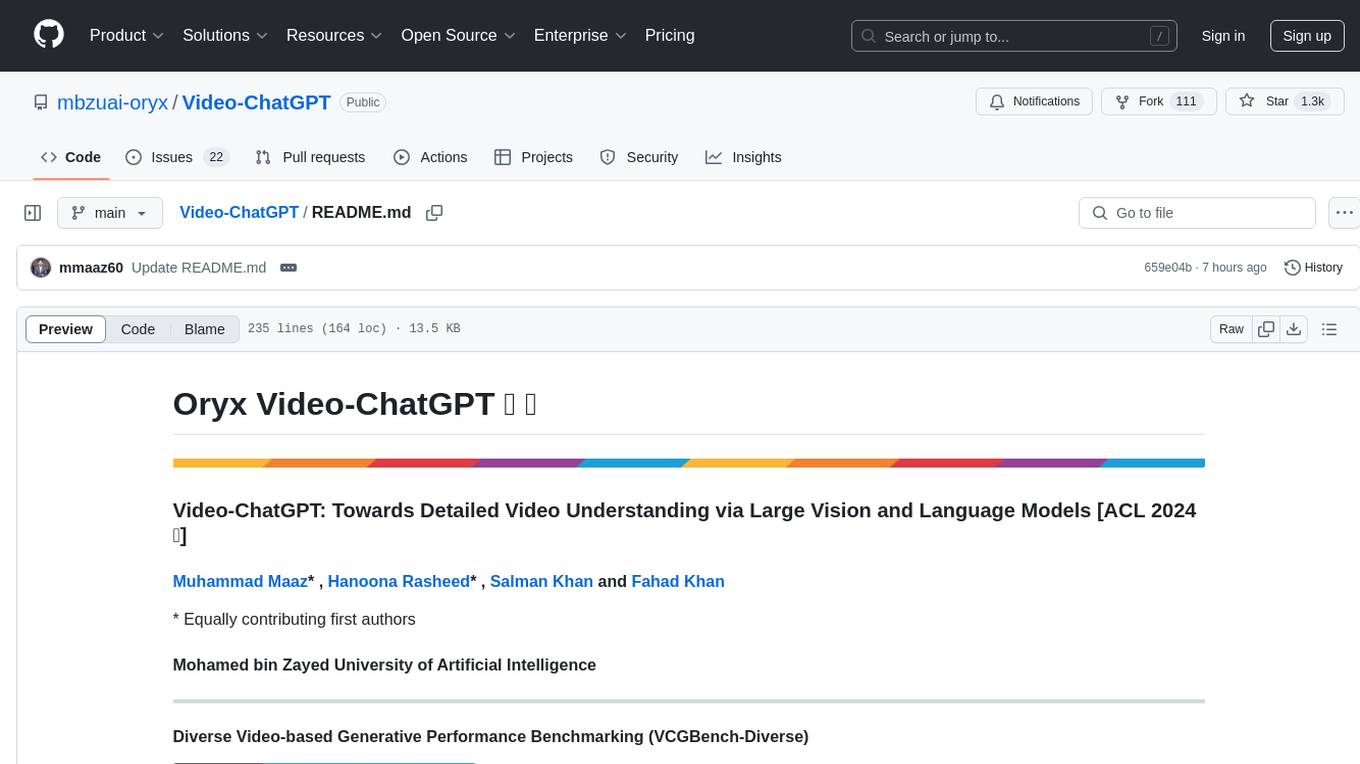
Video-ChatGPT
Video-ChatGPT is a video conversation model that aims to generate meaningful conversations about videos by combining large language models with a pretrained visual encoder adapted for spatiotemporal video representation. It introduces high-quality video-instruction pairs, a quantitative evaluation framework for video conversation models, and a unique multimodal capability for video understanding and language generation. The tool is designed to excel in tasks related to video reasoning, creativity, spatial and temporal understanding, and action recognition.
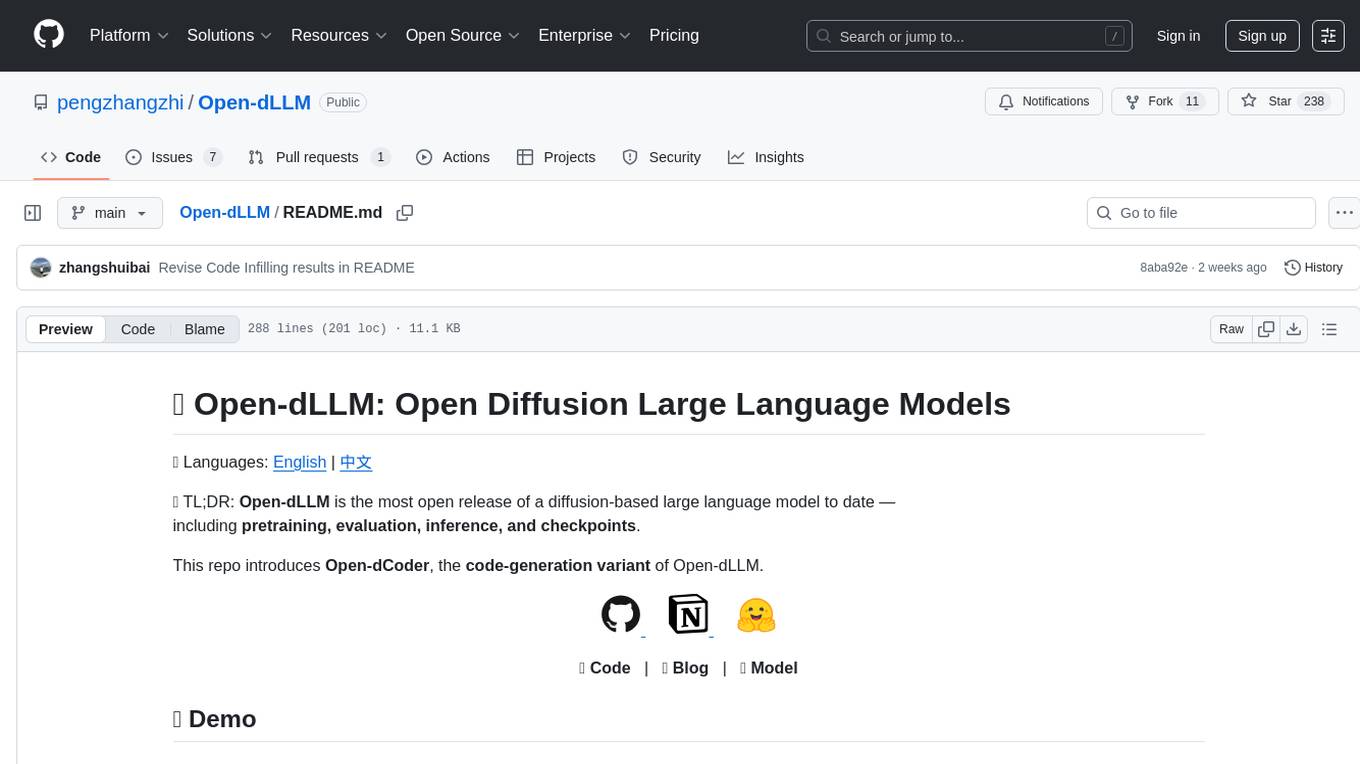
Open-dLLM
Open-dLLM is the most open release of a diffusion-based large language model, providing pretraining, evaluation, inference, and checkpoints. It introduces Open-dCoder, the code-generation variant of Open-dLLM. The repo offers a complete stack for diffusion LLMs, enabling users to go from raw data to training, checkpoints, evaluation, and inference in one place. It includes pretraining pipeline with open datasets, inference scripts for easy sampling and generation, evaluation suite with various metrics, weights and checkpoints on Hugging Face, and transparent configs for full reproducibility.
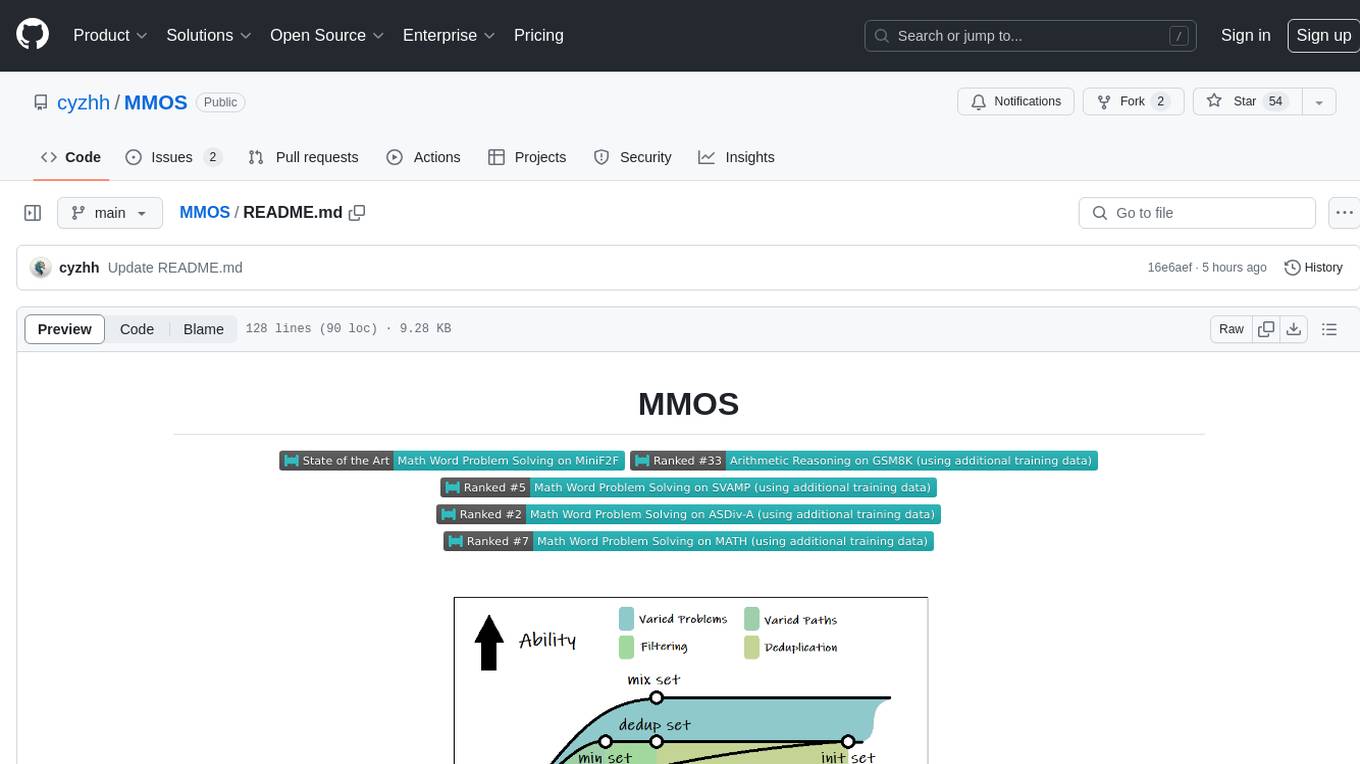
MMOS
MMOS (Mix of Minimal Optimal Sets) is a dataset designed for math reasoning tasks, offering higher performance and lower construction costs. It includes various models and data subsets for tasks like arithmetic reasoning and math word problem solving. The dataset is used to identify minimal optimal sets through reasoning paths and statistical analysis, with a focus on QA-pairs generated from open-source datasets. MMOS also provides an auto problem generator for testing model robustness and scripts for training and inference.
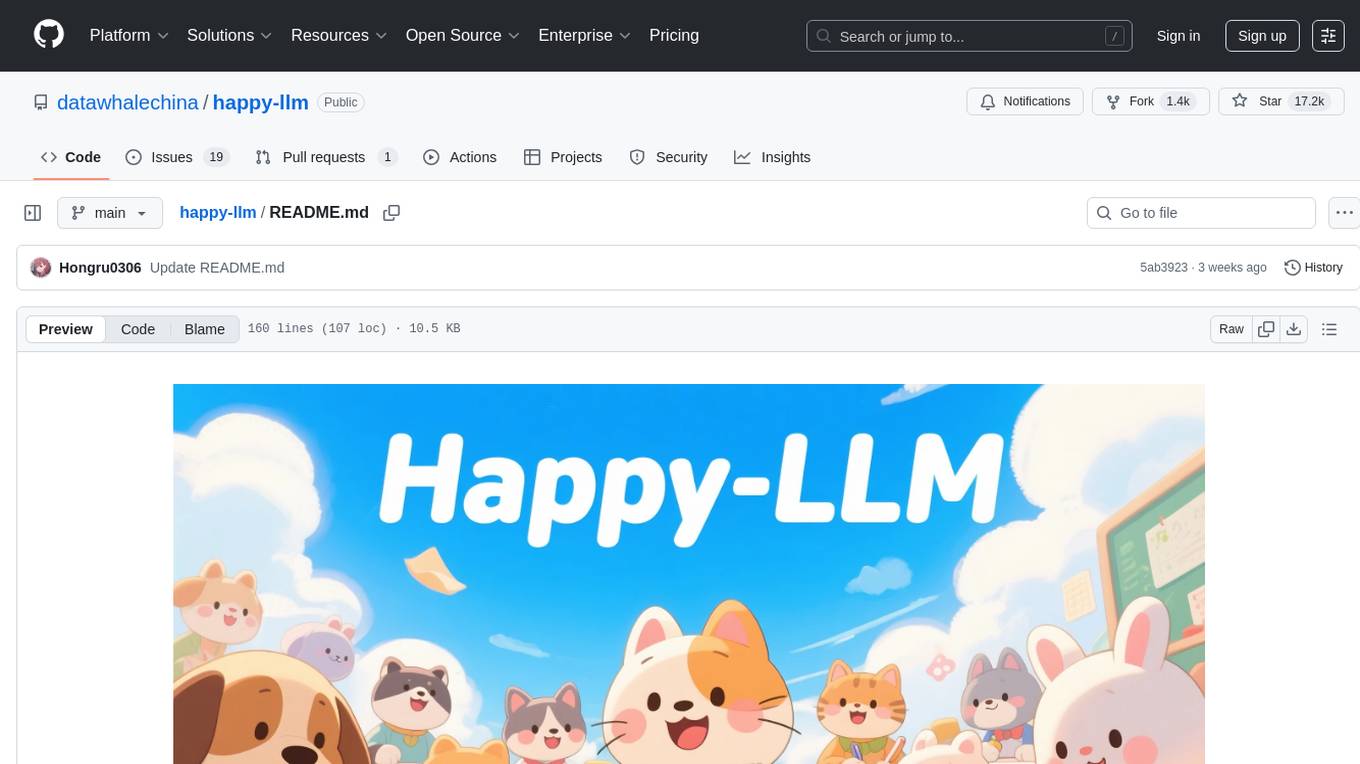
happy-llm
Happy-LLM is a systematic learning tutorial for Large Language Models (LLM) that covers NLP research methods, LLM architecture, training process, and practical applications. It aims to help readers understand the principles and training processes of large language models. The tutorial delves into Transformer architecture, attention mechanisms, pre-training language models, building LLMs, training processes, and practical applications like RAG and Agent technologies. It is suitable for students, researchers, and LLM enthusiasts with programming experience, Python knowledge, and familiarity with deep learning and NLP concepts. The tutorial encourages hands-on practice and participation in LLM projects and competitions to deepen understanding and contribute to the open-source LLM community.
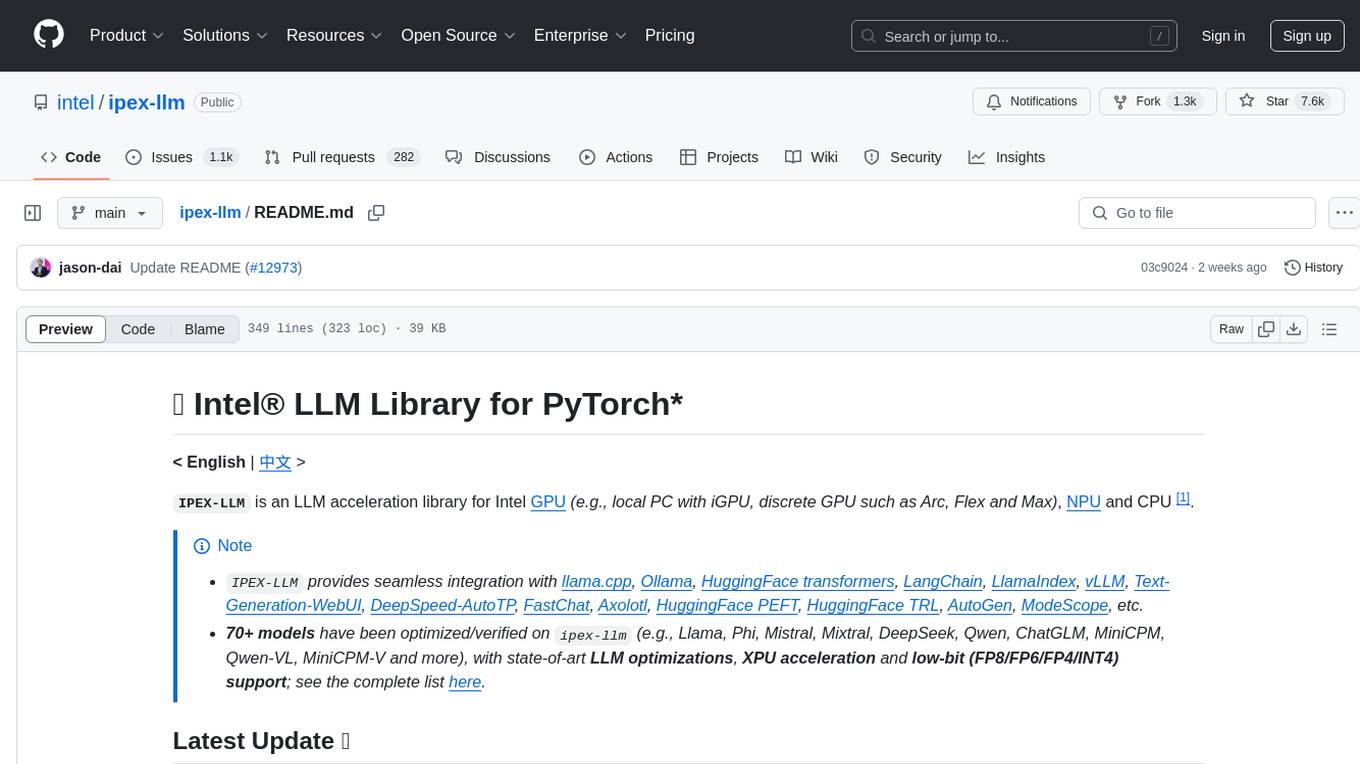
ipex-llm
The `ipex-llm` repository is an LLM acceleration library designed for Intel GPU, NPU, and CPU. It provides seamless integration with various models and tools like llama.cpp, Ollama, HuggingFace transformers, LangChain, LlamaIndex, vLLM, Text-Generation-WebUI, DeepSpeed-AutoTP, FastChat, Axolotl, and more. The library offers optimizations for over 70 models, XPU acceleration, and support for low-bit (FP8/FP6/FP4/INT4) operations. Users can run different models on Intel GPUs, NPU, and CPUs with support for various features like finetuning, inference, serving, and benchmarking.
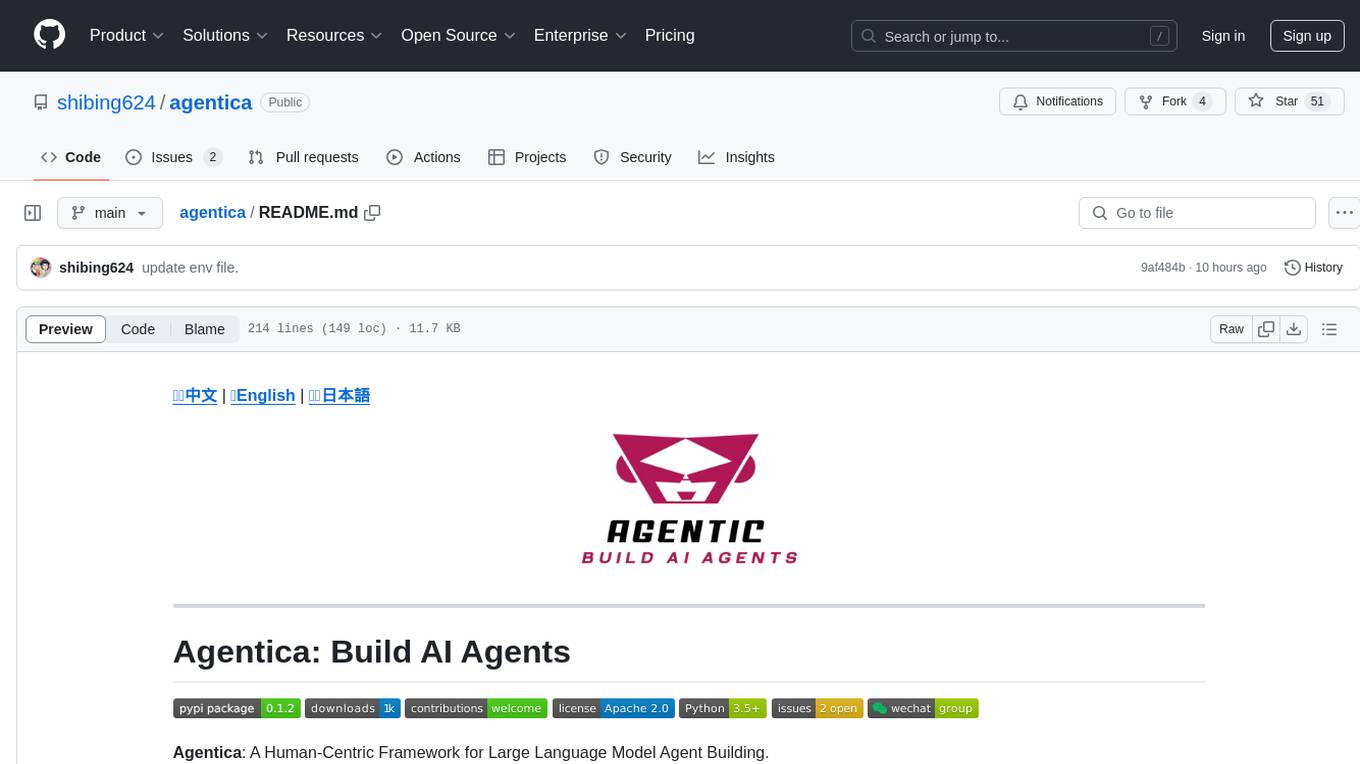
agentica
Agentica is a human-centric framework for building large language model agents. It provides functionalities for planning, memory management, tool usage, and supports features like reflection, planning and execution, RAG, multi-agent, multi-role, and workflow. The tool allows users to quickly code and orchestrate agents, customize prompts, and make API calls to various services. It supports API calls to OpenAI, Azure, Deepseek, Moonshot, Claude, Ollama, and Together. Agentica aims to simplify the process of building AI agents by providing a user-friendly interface and a range of functionalities for agent development.
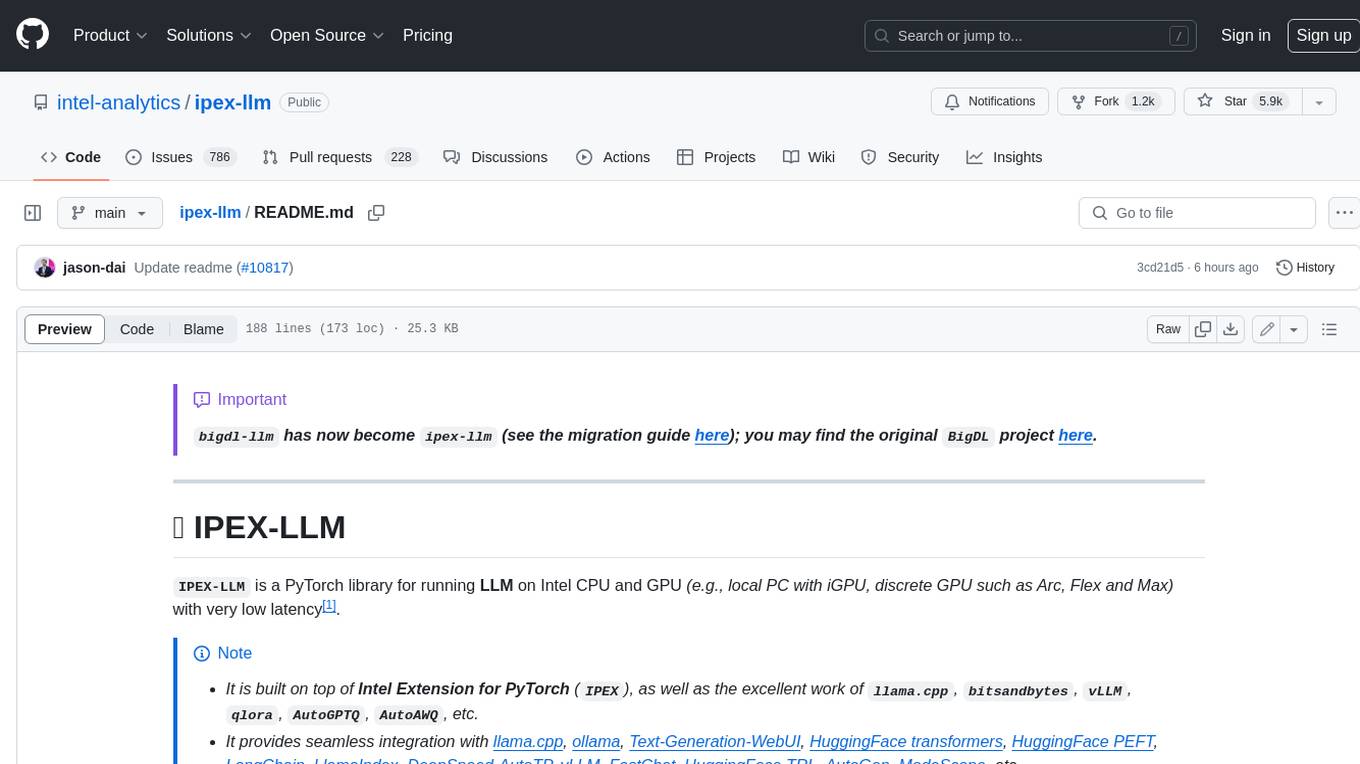
ipex-llm
IPEX-LLM is a PyTorch library for running Large Language Models (LLMs) on Intel CPUs and GPUs with very low latency. It provides seamless integration with various LLM frameworks and tools, including llama.cpp, ollama, Text-Generation-WebUI, HuggingFace transformers, and more. IPEX-LLM has been optimized and verified on over 50 LLM models, including LLaMA, Mistral, Mixtral, Gemma, LLaVA, Whisper, ChatGLM, Baichuan, Qwen, and RWKV. It supports a range of low-bit inference formats, including INT4, FP8, FP4, INT8, INT2, FP16, and BF16, as well as finetuning capabilities for LoRA, QLoRA, DPO, QA-LoRA, and ReLoRA. IPEX-LLM is actively maintained and updated with new features and optimizations, making it a valuable tool for researchers, developers, and anyone interested in exploring and utilizing LLMs.
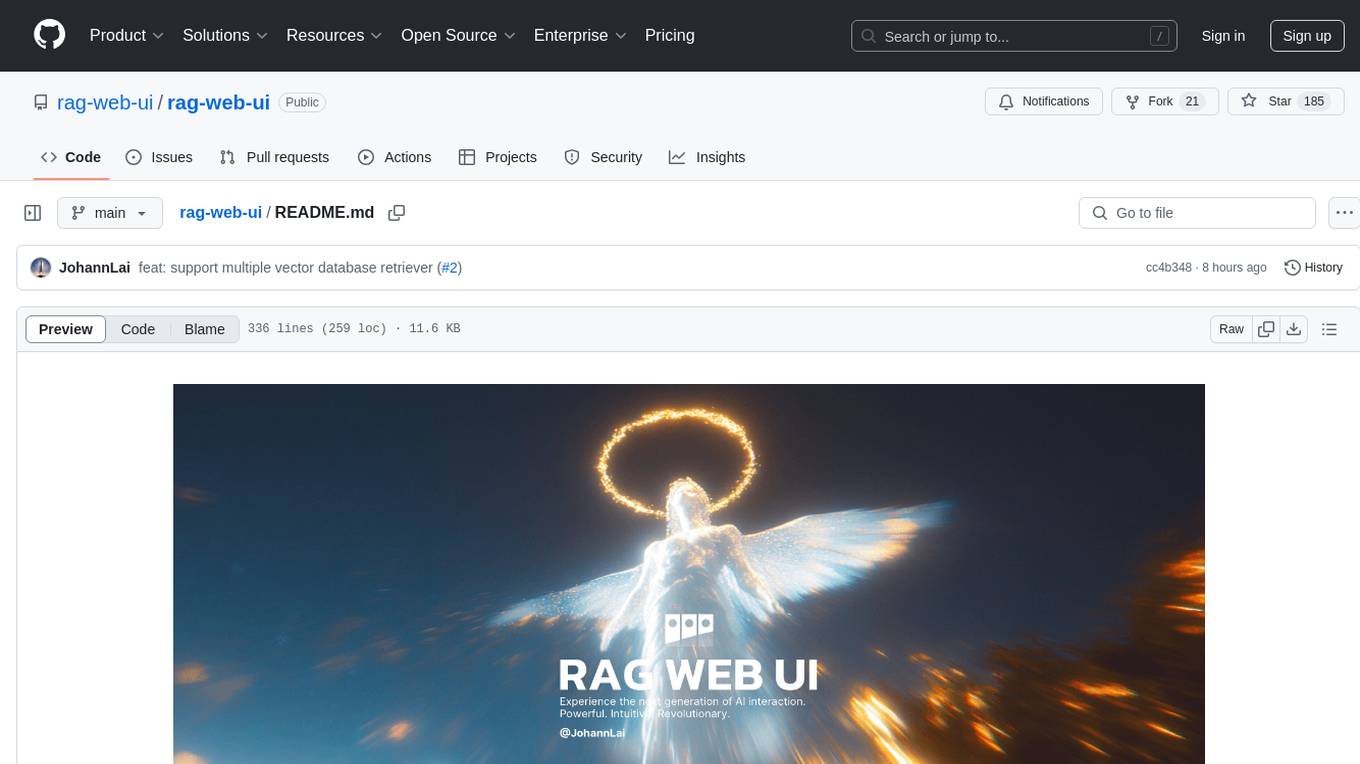
rag-web-ui
RAG Web UI is an intelligent dialogue system based on RAG (Retrieval-Augmented Generation) technology. It helps enterprises and individuals build intelligent Q&A systems based on their own knowledge bases. By combining document retrieval and large language models, it delivers accurate and reliable knowledge-based question-answering services. The system is designed with features like intelligent document management, advanced dialogue engine, and a robust architecture. It supports multiple document formats, async document processing, multi-turn contextual dialogue, and reference citations in conversations. The architecture includes a backend stack with Python FastAPI, MySQL + ChromaDB, MinIO, Langchain, JWT + OAuth2 for authentication, and a frontend stack with Next.js, TypeScript, Tailwind CSS, Shadcn/UI, and Vercel AI SDK for AI integration. Performance optimization includes incremental document processing, streaming responses, vector database performance tuning, and distributed task processing. The project is licensed under the Apache-2.0 License and is intended for learning and sharing RAG knowledge only, not for commercial purposes.
For similar tasks

LLMStack
LLMStack is a no-code platform for building generative AI agents, workflows, and chatbots. It allows users to connect their own data, internal tools, and GPT-powered models without any coding experience. LLMStack can be deployed to the cloud or on-premise and can be accessed via HTTP API or triggered from Slack or Discord.

ai-guide
This guide is dedicated to Large Language Models (LLMs) that you can run on your home computer. It assumes your PC is a lower-end, non-gaming setup.

onnxruntime-genai
ONNX Runtime Generative AI is a library that provides the generative AI loop for ONNX models, including inference with ONNX Runtime, logits processing, search and sampling, and KV cache management. Users can call a high level `generate()` method, or run each iteration of the model in a loop. It supports greedy/beam search and TopP, TopK sampling to generate token sequences, has built in logits processing like repetition penalties, and allows for easy custom scoring.

jupyter-ai
Jupyter AI connects generative AI with Jupyter notebooks. It provides a user-friendly and powerful way to explore generative AI models in notebooks and improve your productivity in JupyterLab and the Jupyter Notebook. Specifically, Jupyter AI offers: * An `%%ai` magic that turns the Jupyter notebook into a reproducible generative AI playground. This works anywhere the IPython kernel runs (JupyterLab, Jupyter Notebook, Google Colab, Kaggle, VSCode, etc.). * A native chat UI in JupyterLab that enables you to work with generative AI as a conversational assistant. * Support for a wide range of generative model providers, including AI21, Anthropic, AWS, Cohere, Gemini, Hugging Face, NVIDIA, and OpenAI. * Local model support through GPT4All, enabling use of generative AI models on consumer grade machines with ease and privacy.

khoj
Khoj is an open-source, personal AI assistant that extends your capabilities by creating always-available AI agents. You can share your notes and documents to extend your digital brain, and your AI agents have access to the internet, allowing you to incorporate real-time information. Khoj is accessible on Desktop, Emacs, Obsidian, Web, and Whatsapp, and you can share PDF, markdown, org-mode, notion files, and GitHub repositories. You'll get fast, accurate semantic search on top of your docs, and your agents can create deeply personal images and understand your speech. Khoj is self-hostable and always will be.

langchain_dart
LangChain.dart is a Dart port of the popular LangChain Python framework created by Harrison Chase. LangChain provides a set of ready-to-use components for working with language models and a standard interface for chaining them together to formulate more advanced use cases (e.g. chatbots, Q&A with RAG, agents, summarization, extraction, etc.). The components can be grouped into a few core modules: * **Model I/O:** LangChain offers a unified API for interacting with various LLM providers (e.g. OpenAI, Google, Mistral, Ollama, etc.), allowing developers to switch between them with ease. Additionally, it provides tools for managing model inputs (prompt templates and example selectors) and parsing the resulting model outputs (output parsers). * **Retrieval:** assists in loading user data (via document loaders), transforming it (with text splitters), extracting its meaning (using embedding models), storing (in vector stores) and retrieving it (through retrievers) so that it can be used to ground the model's responses (i.e. Retrieval-Augmented Generation or RAG). * **Agents:** "bots" that leverage LLMs to make informed decisions about which available tools (such as web search, calculators, database lookup, etc.) to use to accomplish the designated task. The different components can be composed together using the LangChain Expression Language (LCEL).

danswer
Danswer is an open-source Gen-AI Chat and Unified Search tool that connects to your company's docs, apps, and people. It provides a Chat interface and plugs into any LLM of your choice. Danswer can be deployed anywhere and for any scale - on a laptop, on-premise, or to cloud. Since you own the deployment, your user data and chats are fully in your own control. Danswer is MIT licensed and designed to be modular and easily extensible. The system also comes fully ready for production usage with user authentication, role management (admin/basic users), chat persistence, and a UI for configuring Personas (AI Assistants) and their Prompts. Danswer also serves as a Unified Search across all common workplace tools such as Slack, Google Drive, Confluence, etc. By combining LLMs and team specific knowledge, Danswer becomes a subject matter expert for the team. Imagine ChatGPT if it had access to your team's unique knowledge! It enables questions such as "A customer wants feature X, is this already supported?" or "Where's the pull request for feature Y?"

infinity
Infinity is an AI-native database designed for LLM applications, providing incredibly fast full-text and vector search capabilities. It supports a wide range of data types, including vectors, full-text, and structured data, and offers a fused search feature that combines multiple embeddings and full text. Infinity is easy to use, with an intuitive Python API and a single-binary architecture that simplifies deployment. It achieves high performance, with 0.1 milliseconds query latency on million-scale vector datasets and up to 15K QPS.
For similar jobs
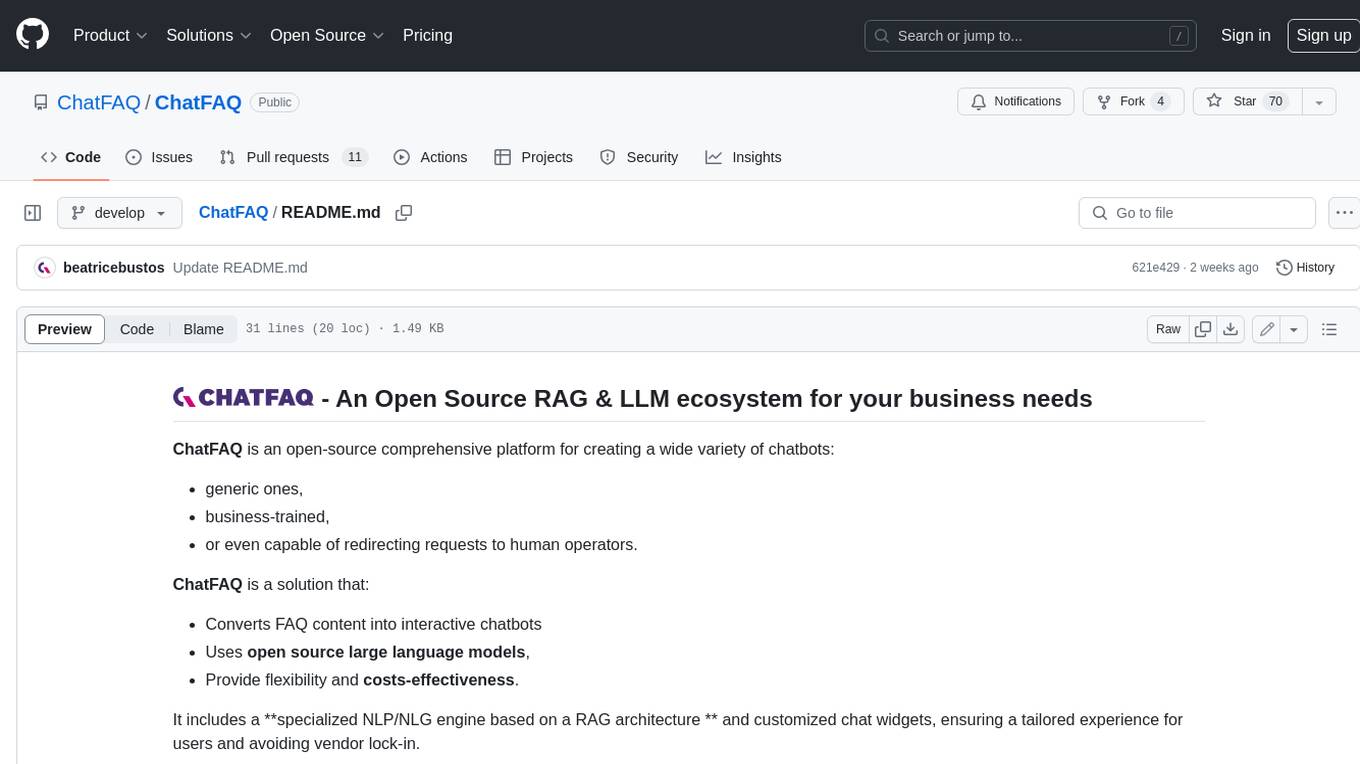
ChatFAQ
ChatFAQ is an open-source comprehensive platform for creating a wide variety of chatbots: generic ones, business-trained, or even capable of redirecting requests to human operators. It includes a specialized NLP/NLG engine based on a RAG architecture and customized chat widgets, ensuring a tailored experience for users and avoiding vendor lock-in.

agentcloud
AgentCloud is an open-source platform that enables companies to build and deploy private LLM chat apps, empowering teams to securely interact with their data. It comprises three main components: Agent Backend, Webapp, and Vector Proxy. To run this project locally, clone the repository, install Docker, and start the services. The project is licensed under the GNU Affero General Public License, version 3 only. Contributions and feedback are welcome from the community.
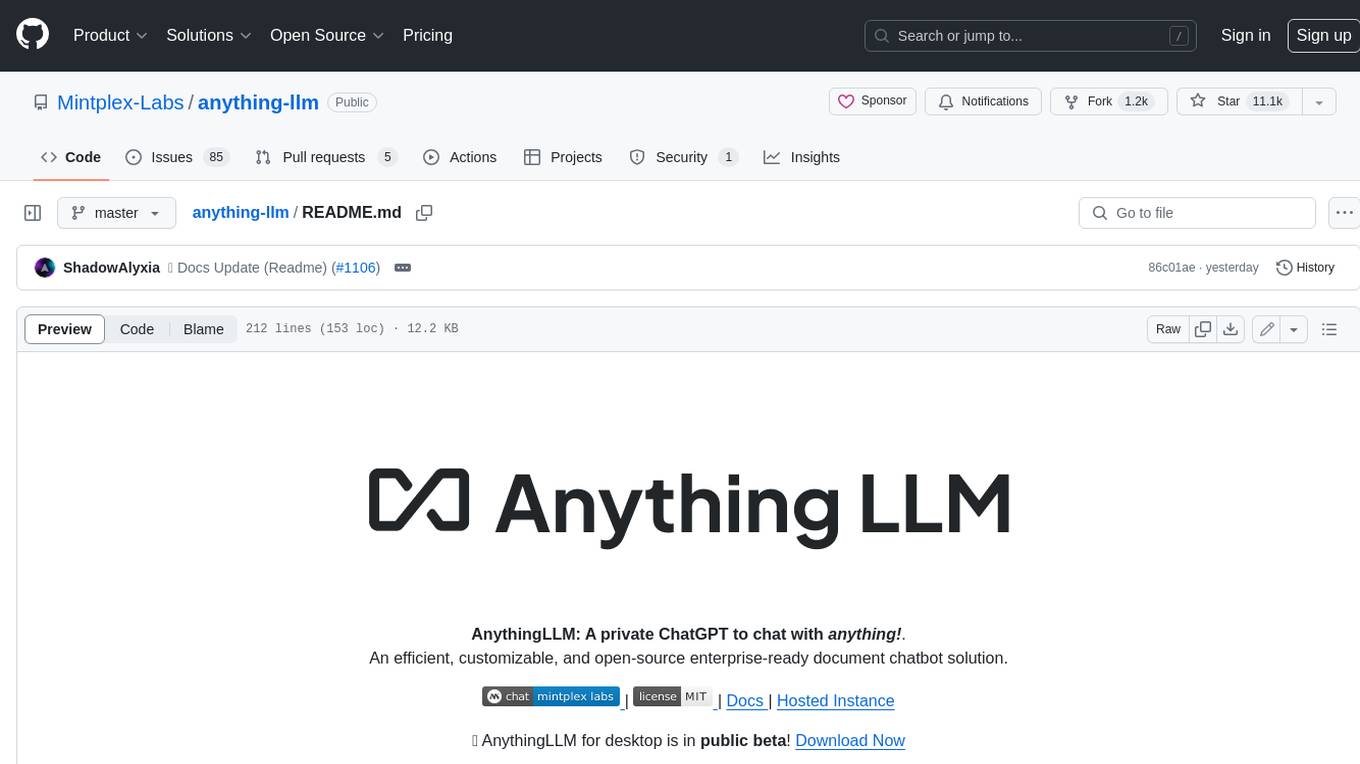
anything-llm
AnythingLLM is a full-stack application that enables you to turn any document, resource, or piece of content into context that any LLM can use as references during chatting. This application allows you to pick and choose which LLM or Vector Database you want to use as well as supporting multi-user management and permissions.

ai-guide
This guide is dedicated to Large Language Models (LLMs) that you can run on your home computer. It assumes your PC is a lower-end, non-gaming setup.

Magick
Magick is a groundbreaking visual AIDE (Artificial Intelligence Development Environment) for no-code data pipelines and multimodal agents. Magick can connect to other services and comes with nodes and templates well-suited for intelligent agents, chatbots, complex reasoning systems and realistic characters.
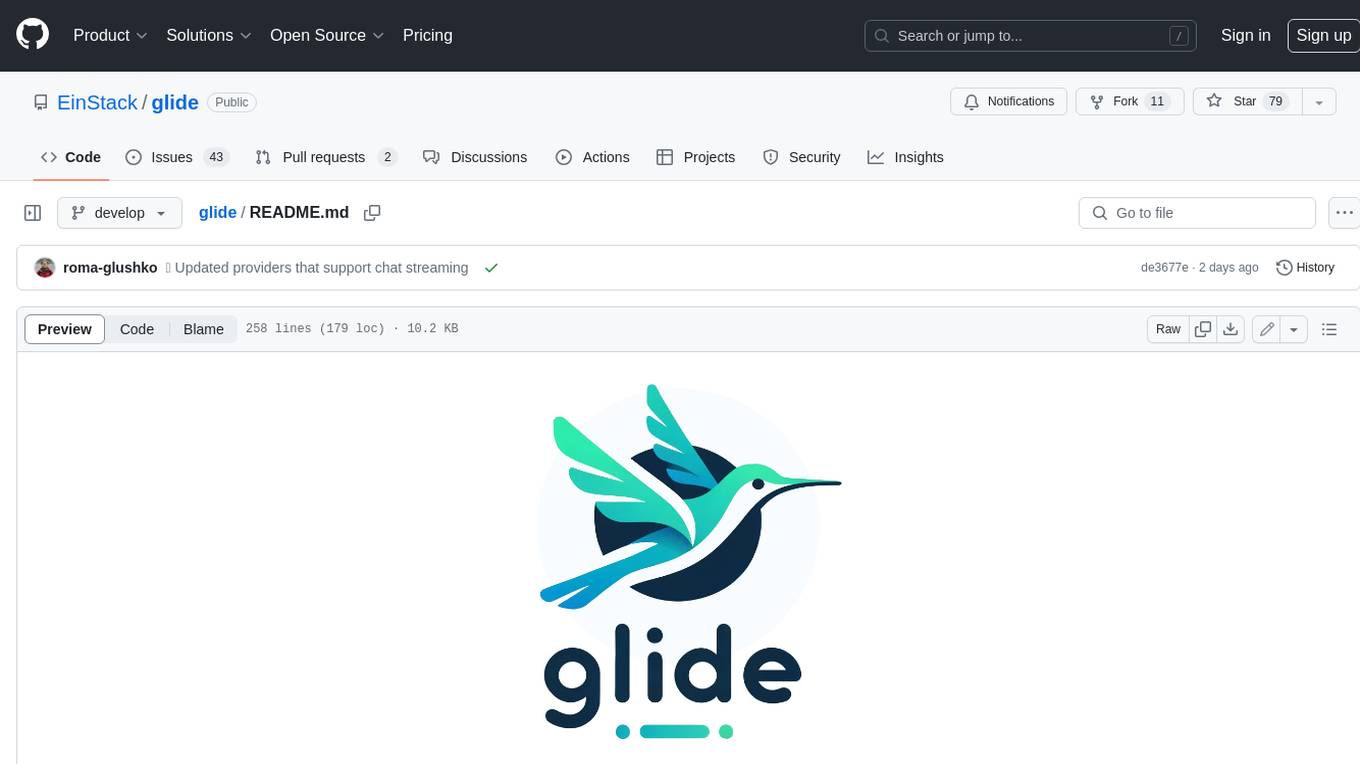
glide
Glide is a cloud-native LLM gateway that provides a unified REST API for accessing various large language models (LLMs) from different providers. It handles LLMOps tasks such as model failover, caching, key management, and more, making it easy to integrate LLMs into applications. Glide supports popular LLM providers like OpenAI, Anthropic, Azure OpenAI, AWS Bedrock (Titan), Cohere, Google Gemini, OctoML, and Ollama. It offers high availability, performance, and observability, and provides SDKs for Python and NodeJS to simplify integration.

chatbot-ui
Chatbot UI is an open-source AI chat app that allows users to create and deploy their own AI chatbots. It is easy to use and can be customized to fit any need. Chatbot UI is perfect for businesses, developers, and anyone who wants to create a chatbot.

onnxruntime-genai
ONNX Runtime Generative AI is a library that provides the generative AI loop for ONNX models, including inference with ONNX Runtime, logits processing, search and sampling, and KV cache management. Users can call a high level `generate()` method, or run each iteration of the model in a loop. It supports greedy/beam search and TopP, TopK sampling to generate token sequences, has built in logits processing like repetition penalties, and allows for easy custom scoring.
